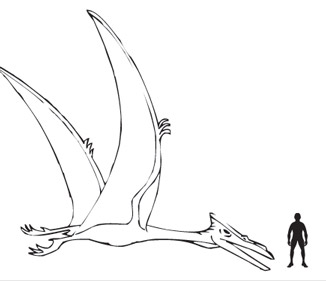Pterosaurs Coming to London to Celebrate 350 Years of the Famous Royal Society
Pterosaurs Swoop into London for the Festival of Science and the Arts
A team of researchers from the University of Portsmouth have created five, life-sized pterosaurs (flying reptiles) to help scientists to understand more about how these animals flew and walked.
This year, marks the 350th anniversary of the founding of the UK’s academy of science and to celebrate this, a summer of special events and activities are being held at London’s Southbank Centre. Taking pride of place at the Southbank Centre’s outdoor arena will be this set of five flying reptiles, the largest with a wingspan in excess of 10 metres.
Pterosaurs
Pterosaurs are an extinct group of flying reptiles that dominated the air during the early part of the Mesozoic. These animals evolved in the Early Triassic and diversified into many forms, some no bigger than garden birds, whilst one type of pterosaur, the azhdarchids, one of the last groups to evolve, grew to enormous sizes making them the largest flying creatures known. The wings of pterosaurs were formed out of skin that stretched from the body over the forelimbs and along an extremely elongated fourth finger that acted as a supporting strut for the wing. These magnificent creatures, not dinosaurs but members of the same branch of the archosaur group as the Dinosauria, became less common towards the end of the Cretaceous and died out at the same time as the dinosaurs.
An Illustration of the Azhdarchid Quetzalcoatlus (Q. northropi)

Picture credit: Everything Dinosaur
Everything Dinosaur stocks a wide range of pterosaur models including Quetzalcoatlus: Dinosaur and Pterosaur Figures.
The research team from the University of Portsmouth are studying pterosaurs to better understand how their skeletons withstood the stress and strain of flying. One of the best ways to understand the forces involved is to build a life-sized pterosaur. Models such as the five going on display in London can help scientists gain a more accurate picture of the stresses involved in flight, aiding the work carried out using computer models and programmes.
Dr David Martill from the School of Earth and Environmental Science (University of Portsmouth) commented:
“Creating these models help us to better understand how these ancient reptiles were able to achieve gigantic proportions and still be able to fly with great manoeuvrability. Studying the skeletons of these amazing creatures could help engineers to design stronger and lighter aircraft frames.”
“Dragons of the Air”
In this free exhibition, entitled: “Pterosaurs – Dragons of the Air”, visitors to London’s Southbank Centre will be able to get up close to the huge models and see real, fossilised pterosaur bones.
The life-size models will not only depict pterosaurs in a flying pose but one model will also show how palaeontologists’s have interpreted the fossil evidence to explain how these creatures walked.
One of the more recent theories regarding the habits and lifestyles of these bizarre creatures is that the later forms, the very large, long-beaked azhdarchids hunted small dinosaurs in the same way that Secretary birds and certain types of stork hunt small mammals and lizards on the plains of Africa today. The models at this exhibition will permit visitors to gain an insight into this current pterosaur research.
To read an article on terrestrial hunting pterosaurs: Getting Stalked by a Flock of Quetzalcoatlus.

